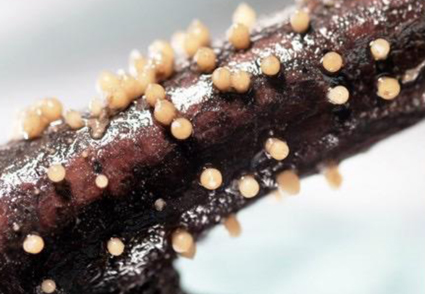Abstract
A new deep-sea fungus, Oceanitis abyssalis sp. nov. was described based on analyses of the LSU rDNA sequences and morphological characteristics. The new species was found on a branch of Prunus sp. collected at 5707 m depth of the abyssal plain in the Northwest Pacific Ocean, east off the Japan Islands. To the best of our knowledge, our discovery is the deepest record of the genus Oceanitis and also for the obligate deep-sea fungi. Morphologically, Oceanitis abyssalis is closely similar to O. scuticella Kohlmeyer and both were collected from deep-sea water. Oceanitis abyssalis can be distinguished from O. scuticella by having unicellular ascospores, smaller deciduous polar appendages and occasionally tree-like appendages, semi-persistent asci, smaller ascomata that are drop-shaped, and cream-colored. We also reviewed the taxonomic status of O. scuticella. The phylogenetic position of the authentic O. scuticella remains unclear due to the lack of genetic information and the inaccessibility of the type specimen. However, our investigation of the molecular and morphological characteristics of specimens previously identified as O. scuticella suggests that they include several cryptic, undescribed species. Notably, the Kuril-Kamchatka Trench material (M0229768), previously identified as O. scuticella, is suggested to be a representative of Oceanitis abyssalis.
References
- Abdel-Wahab, M.A. & Nagahama, T. (2012) Halosarpheia japonica sp. nov. (Halosphaeriales, Ascomycota) from marine habitats in Japan. Mycological Progress 11: 85–92. https://doi.org/10.1007/s11557-010-0731-0
- Borneman, J. & Hartin, R.J. (2000) PCR primers that amplify fungal rRNA genes from environmental samples. Applied and environmental microbiology 66 (10): 4356–4360. https://doi.org/10.1128/AEM.66.10.4356-4360.2000
- Dupont, J., Magnin, S., Rousseau, F., Zbinden, M., Frebourg, G., Samadi, S., de Forges, B.R. & Jones, E.B.G. (2009) Molecular and ultrastructural characterization of two ascomycetes found on sunken wood off Vanuatu islands in the deep Pacific Ocean. Mycological Research 113: 1351–1364. https://doi.org/10.1016/j.mycres.2009.08.015
- Dupont, J. & Schwabe, E. (2016) First evidence of the deep-sea fungus Oceanitis scuticella Kohlmeyer (Halosphaeriaceae, Ascomycota) from the Northern Hemisphere. Botanica Marina 59: 275–282. https://doi.org/10.1515/bot-2016-0030
- Gardes, M. & Bruns, T.D. (1993) ITS primers with enhanced specificity for Basidiomycetes-application to the identification of Mycorrhizae and Rusts. Molecular Ecology 2 (2): 113–118. https://doi.org/10.1111/j.1365-294X.1993.tb00005.x
- Jones, E.B.G. & Le Campion-Alsumard, T. (1970a) Marine fungi on polyurethane covered plates submerged in the sea. Nova Hedwigia 19: 567–585.
- Jones, E.B.G. & Le Campion-Alsumard, T. (1970b) The biodeterioration of polyurethane by marine fungi. International Biodeterioration Bulletin 6: 119–124.
- Kohlmeyer, J. (1969) Deterioration of wood by marine fungi in the deep sea. Material Performance and the Deep Sea, Special Technical Publication 445: 20–30.
- Kohlmeyer, J. (1977) New-genera and species of higher fungi from deep-sea (1615-5315 M)-(1). Revue de Mycologie 41: 189–206.
- Kohlmeyer, J. & Kohlmeyer, E. (1965) New marine fungi from mangroves and trees along eroding shorelines. Nova Hedwigia 9: 89–104.
- Nagano, Y., Fujiwara, Y., Nishimoto, A., Haga, T. & Fujikura, K. (2019) Deep-sea endemic fungi? The discovery of Alisea longicolla from artificially immersed wood in deep sea off the Nansei Islands, Japan. Mycoscience 60 (4): 228–231. https://doi.org/10.1016/j.myc.2019.03.004
- Nagano, Y. & Nagahama, T. (2012) Fungal diversity in deep-sea extreme environments. Fungal Ecology 5 (4): 463–471. https://doi.org/10.1016/j.funeco.2012.01.004
- Nakajima, R., Tsuchiya, M., Yabuki, A., Masuda, S., Kitahashi, T., Nagano, Y., Ikuta, T., Isobe, N., Nakata, H., Ritchie, H., Oguri, K., Osafune, S., Kawamura, K., Suzukawa, M., Yamauchi, T., Iijima, K., Yoshida, T., Chiba, S. & Fujikura, K. (2021) Massive occurrence of benthic plastic debris at the abyssal seafloor beneath the Kuroshio Extension, the North West Pacific. Marine Pollution Bulletin 166: 112188. https://doi.org/10.1016/j.marpolbul.2021.112188
- Nei, M. & Kumar, S. (2000) Molecular Evolution and Phylogenetics. Oxford University Press, New York, 126 pp.
- Noureldin, A.A.H., Abdel-Aziz, F.A. & Abdel-Wahab, M.A. (2022) Qarounispora grandiappendiculata gen. et sp. nov. (Halosphaeriaceae, Microascales) from Qaroun Lake, Egypt. Phytotaxa 530 (1): 86–94. https://doi.org/10.11646/phytotaxa.530.1.7
- Overy, D.P., Rämä, T., Oosterhuis, R., Walker, A.K. & Pang, K.-L. (2019) The neglected marine fungi, sensu stricto, and their isolation for natural products’ discovery. Marine Drugs 17 (1): 42. https://doi.org/10.3390/md17010042
- Raghukumar, S. (2017) Extreme marine environments. In: Fungi in Coastal and Oceanic Marine Ecosystems. Berlin: Springer, pp. 219–264. https://doi.org/10.1007/978-3-319-54304-8
- Sakayaroj, J., Pang, K.L. & Jones, E.B.G. (2011) Multi-gene phylogeny of the Halosphaeriaceae: its ordinal status, relationships between genera and morphological character evolution. Fungal Diversity 46: 87–109. https://doi.org/10.1007/s13225-010-0072-y
- Shearer, C. & Crane, J.L. (1980) Fungi of the Chesapeake Bay and its tributaries VIII. Ascomycetes with unfurling appendages. Botanica Marina 23: 607–615.
- Tamura, K., Stecher, G. & Kumar, S. (2021) MEGA11: Molecular Evolutionary Genetics Analysis Version 11. Molecular biology and evolution 38 (7): 3022–3027. https://doi.org/10.1093/molbev/msab120
- Wijayawardene, N.N., Hyde, K.D., Lumbsch, H.T., Liu, J.K., Maharachchikumbura, S.S.N., Ekanayaka, A.H., Tian, Q. & Phookamsak, R. (2018) Outline of Ascomycota: 2017. Fungal Diversity 88: 167–263. https://doi.org/10.1007/s13225-018-0394-8
- White, T.J., Bruns, T., Lee, S. & Taylor, J. (1990) 38 - Amplification and direct sequencing of fungal ribosomal RNA genes for phylogenetics. In: PCR Protocols: a guide to methods and applications. New York: Academic Press, pp. 315–322. https://doi.org/10.1016/B978-0-12-372180-8.50042-1
- Vilgalys, R. & Hester, M. (1990) Rapid genetic identification and mapping of enzymatically amplified ribosomal DNA from several Cryptococcus species. Journal of Bacteriology 172: 4238–4246. https://doi.org/10.1128/jb.172.8.4238-4246.1990
- Vishwakiran, Y., Thakur, N.L., Raghukumar, S., Yennawar, P.L. & AnilFrom, A.C. (2001) Spatial and Temporal Distribution of Fungi and Wood-Borers in the Coastal Tropical Waters of Goa, India. Botanica Marina 44 (1): 47–56. https://doi.org/10.1515/BOT.2001.007


